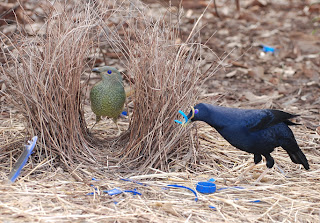 |
| Bowerbirds |
Male bowerbirds use
their intelligence to impress the females, constructing elaborate structures
called bowers to attract mates. They are not on master builders, but also
accomplished artists. Males of some species decorate their bowers
lavishly with
flower petals and sparkly manmade objects. The Satin bowerbird even paints the
walls of his bower with charcoal or chewed up berries. Male Great bowerbirds
are even more remarkable. Their bowers, which are among the most complex of
all, are true marvels of avian architecture. But as well as being builders and
artists, males of this species are also magicians - the bowers they build are
like a house of illusions, with built-in visual tricks that manipulate females'
perceptions and increase their likelihood of choosing the builder as their
mate.
Bowerbirds are a family of twenty species that are native to Australia and New
Guinea that are renowned for their unusually complex mating behavior. The Great bowerbird of northern
Australia is the largest species in the family. Males sport brownish-grey
plumage build bowers, and spend many months building their bowers. The bowers
consist of a thatched twig tunnel forming an avenue of approximately half a meter
in length, opening out onto a court whose floor is covered with bones, shells
and stones. When a potential mate steps into the avenue, the male stands in the
court just by the avenue's exit, displaying to her the colorful objects he has
collected, one after the other.
This species creates a
courtyard with large objects placed toward the back and smaller objects placed
toward the front, nearer to where the female approaches. The overall effect is
that the courtyard looks smaller overall than it actually is. The male great
bowerbird very specifically designs and arranges his bower in such a manner,
though why it works to woo the females is still unknown. Even more interesting,
this is the only species of animal known to build something that creates
perspective. But the talent of bowerbirds doesn't stop with geometry. There is
also color coordination.
It is reported that, the males use visual
illusions when constructing their bowers. They do so by arranging the objects
covering the floor of the court in a particular way, so that they increase in
size as the distance from the bower increases. This positive size-distance
gradient creates a forced perspective which results in false perceptions of the
geometry of the bower, which is visible only to the female when she is standing
in the avenue. From her point of view, all of the objects in the court appear
to be the same size. Consequently, she may perceive the court as being smaller
than it actually is, and the male to be bigger.
Analysis of research data
revealed that the geometry of the bower was directly related to the mating
success of its builder. The most successful males were the ones that had
arranged the objects to form the most regular patterns on the floor of the
court. There was also a direct relationship between the regularity of the
pattern formed by the objects in the court and the strength of the forced
perspective illusion.
As better gradients
produce more even patterns when seen from within the avenue, the males go to great lengths examining their
work and rearranging objects to make the pattern as even as possible. Males
spend most of their time on the bower going into the avenue and looking out,
then moving objects, going back into the avenue, and so on. When in the avenue,
they also sometimes fix the twigs in the walls, too. The researchers still
don't know if this results in an improvement of the illusion.
As well as making the court seem smaller, the
illusion created by a regular pattern may make the male's displayed objects
stand out more, because a regular background pattern is less distracting than
an irregular one. It is noted that, the displayed objects are slightly larger
than the perceived size of the objects arranged on the floor of the court. This
may produce another illusion of relative size perception, called the Ebbinghaus illusion, whereby an object is
perceived as larger when viewed next smaller ones, or smaller when next to
larger ones.
Chickens, thrushes,
pigeons and parrots have all been shown be sensitive to various illusions, and
males of many species display themselves to females at a characteristic angle
and distance. This suggests that the use of illusions might be widespread in
birds. Females of many bird species are known to prefer males with larger colored
patches on their bodies, and it is possible that the Ebbingaus illusion could
be used by males of those species to increase the apparent size of their
patches. So, too, could the related Wundt-Jastrow illusion, in which an object
appears smaller when its shorter edge is next to the longer edge of an object
of the same size.



No comments:
Post a Comment